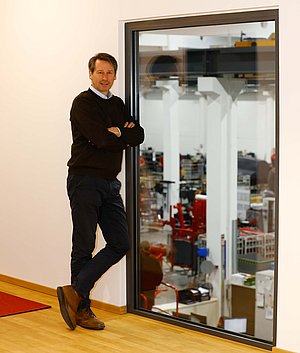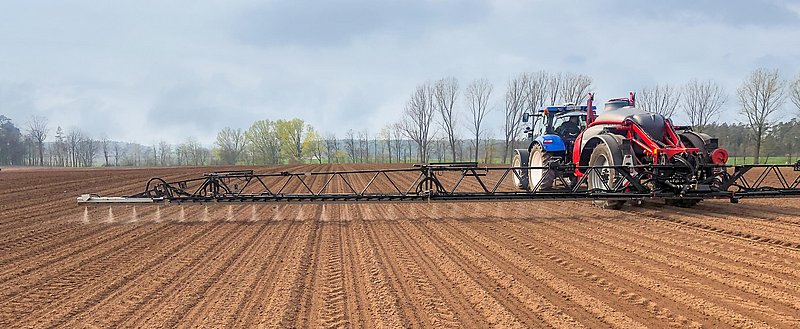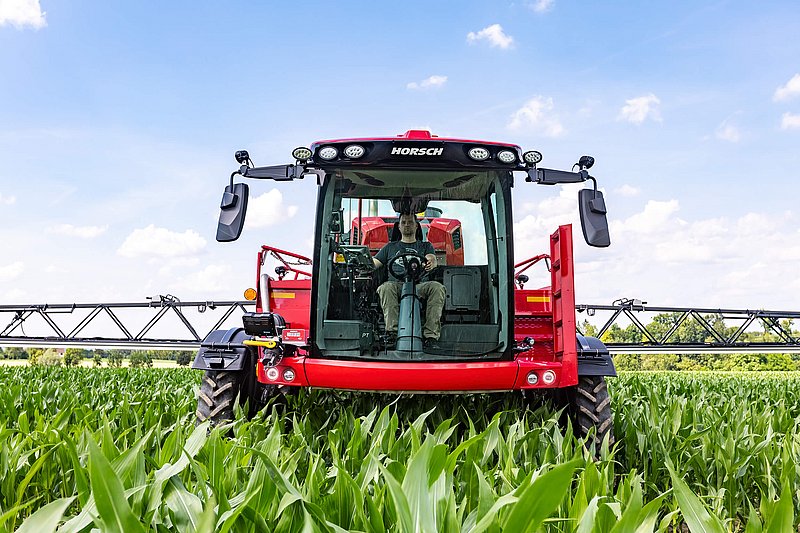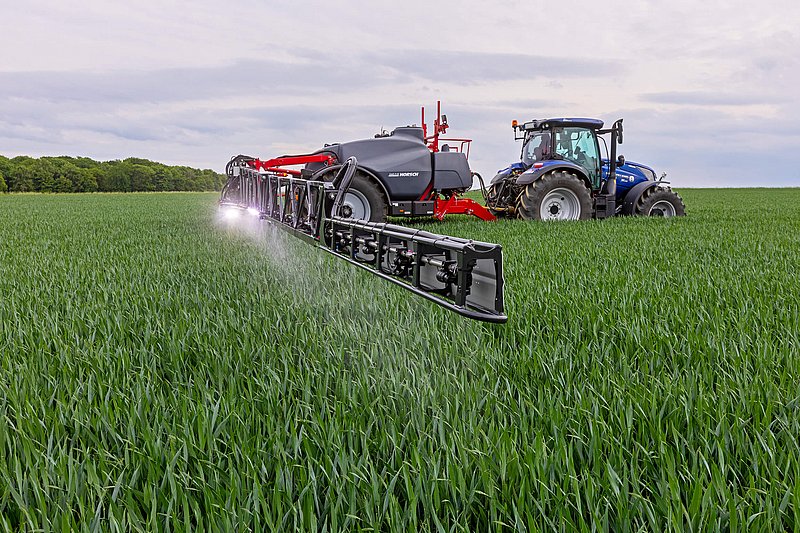Becoming a full liner
„When can I finally buy a mounted sprayer from you?“ HORSCH dealers have got used to hearing this question more and more often And this wish soon will come true. terraHORSCH talked to Theo Leeb about the current development status, the additional expansion of the new self-propelled sprayer line and his thoughts about the future of plant protection.

terraHORSCH: In the interview for the special issue of the terraHORSCH for the Agritechnica 2019 you already mentioned that you are on the way to becoming a full liner in the sector of plant protection technology. Were you talking about a mounted sprayer?
Theo Leeb: The developments in this sector are really advancing fast. In autumn 2020, there will already be a first prototype with a tank capacity of 2,000 litres. For spring 2021, we are planning to produce the first pre-series. The mounted sprayer will probably be available with three different tank sizes: 1,200 litres, 1,600 litres and 2.000 litres. It will be possible to expand each version with a front tank to increase the capacity even further.
terraHORSCH: How will the mounted sprayer stand out from the other sprayers on the market?
Theo Leeb: In the mounted sprayers, too, we will include a lot of new ideas and well-proven technologies from our previous range. This has always been a guarantor of success when we extended our existing sprayer range. The solutions in the sectors boom control, pump output, cleaning, handling and coupling to the tractor will stand out considerably from the previous standards. On the technical side the standard BoomControl system for an automatic boom control excels. This system is also used for our trailed and self-propelled sprayers. A hydraulic drive of the spraying pump combined with an intelligent coupling system allows for placing the centre of gravity of the mounted sprayer very closely to the tractor. At the same time, it guarantees a quick and simple coupling to the tractor as no drive shaft is required. With regard to the water system we alternatively rely on CCS and CCS Pro which we already use for the trailed plant protection sprayers Leeb LT or Leeb GS. A rotary pump guarantees an output of 400 litres per minute. Moreover, an automatic inside cleaning system is integrated in this system.
The boom widths will range from 15 to 30 m and a one-side folding will be available as an option.

terraHORSCH: Which customers are your target group for the mounted sprayer?
Theo Leeb: Our target group are customers who because of their farm structure cannot use a trailed plant protection sprayer, e.g. farms with fields that are located on extreme slopes or farms with mainly small fields. First and foremost, the mounted sprayer will meet the requirements of the Western European market. The key markets will mainly be Germany, France, Great-Britain, Austria and Switzerland. We know exactly where the demands for this kind of product come from.
terraHORSCH: In the Agritechnica issue of the terraHORSCH you told us that a lot of variable equipment versions will be available for the new self-propelled sprayer line. Why does HORSCH LEEB position itself on a broader base in the self-propelled sprayer sector?
Theo Leeb: As I have already mentioned we are on the way to becoming a full liner in the sector of plant protection technology. We want to provide each farmer with the appropriate technology for his farm. All over the world the general conditions differ widely from country to country and from farming region to farming region. The market in Western Europe requires other product characteristics than the market in Eastern Europe which again are different on the North American market. In detail this particularly concerns clearance, variably adjustable track widths, tank capacity, total weight, comfort, engine power, emission levels and legal stipulations. Regions which for example mainly grow sunflowers have different requirements on a self-propelled sprayer than cereal-growing regions. Another example is that in Germany there is an increased demand for an adjustable track (e.g. for contractors). In other countries, this only plays a minor role. We want to supply the relevant agricultural markets all over the world with the perfectly appropriate self-propelled sprayer concepts. With the variable equipment options, we can meet all the requirements in an optimum way.

terraHORSCH: How do you realise the technical side? Will there be more expansions for the new self-propelled sprayer line than those we already know about?
Theo Leeb: There will be three different self-propelled sprayer versions. You already know the new Leeb PT 6.300 and 8.300 with a tank capacity of 6,000 litres or 8,000 litres. It was already exhibited at the Agritechnica show. One special feature is the transverse control arm wheel suspension system with hydropneumatic suspension. This sprayer line is available with a fixed track setting of 2 to 2.5 m and in the future will also be available with a 5,000-litre tank.
The other two self-propelled sprayer versions are the VN and the VL. The new self-propelled sprayer line VN (variable narrow) is equipped with telescopic axles, a new individual wheel suspension and a variably adjustable track adjustment. The latter will either range from 1.80 m to 2.25 m or from 2.25 m to 3 m. The customer can choose which version suits him best. As an option, the track adjustment from 2.25 m to 3 m can be equipped with a height adjustment up to 2 m. To begin with, the VN will be available with a tank capacity of 5,000 litres or 6,000 litres. The whole concept has mainly been developed for the requirements of the European market and with regard to the range of use reminds one of the PT 350. At the end of the year we will build the first prototype and the plan is to build the first pre-series in spring 2021.
The third new self-propelled sprayer version VL (variable large) has been designed for the global market. The VL is equipped with a similar axle and wheel suspension concept. The variably adjustable track width is available in two ranges - between 2.6 m and 3.50 m and between 3 m and 4 m. Both can be equipped with an optional height adjustment of up to 2 m. At first, the VL will be available with a tank capacity of 6,000 l and 8,000 l. We are just building the first protypes. The colleagues and customers in the Ukraine, Russia, Hungary, North America, Brazil and Australia are already looking forward to the first tests and experiences with the machines and the innovations we will, of course, include. Moreover, there will be an entry-level version with a capacity of 4,000 l.
terraHORSCH: Are there any news in the sector of trailed plant protection sprayers?
Theo Leeb: We are currently working on considerably expanding the Leeb AX line which at the moment is available with a tank capacity of 3,800 l. I.e. in the future there will also be tank capacities between 3,800 l and 8,000 l for the Leeb AX.

terraHORSCH: Band spraying is one of the developments in the plant protection sector that might get more attention in the future. What are your experiences in this sector?
Theo Leeb: Band spraying is a method where only the plant rows or the spaces in-between are treated. It can be compared to a site-specific treatment which is carried out in strips on the whole field. The aim is to apply the plant protection agent more precisely and to reduce the application rate of the agent. This method was already used 35 years ago, however with very narrow working widths or combined with hoeing machines. One problem was the area output, another one, in combination with hoeing devices, the different optimum operating conditions. For hoeing it ought to be rather dry. Temperature and wind are not important. The optimum operating time for band spraying, however, strongly depends on wind and temperature. This is one of the reasons why this method has not been practised very intensely during the past years. However, because of the dwindling active agent variance and the increasing environmental regulations this technology becomes more and more important again. At the same time, it is very important to also increase the area output and to be as flexible as possible with regard to the application times. Some years ago, we already started thinking about applying the agent with a surface sprayer – equipped with small-cone nozzles – on the plant row or between the plant rows. Due to our 25 cm nozzle layout it is easy to select the target area row or intermediate row. This is the reason why, for four years, we have been doing comprehensive research and tests in the sector of band spraying. And so far, we have noticed that two important requirements have to be met: First, the boom control system is very important – at the moment, we surely are setting standards with our BoomControl system. For an optimum band spraying the boom has to be controlled very precisely. Secondly, the row spacings are important, too. For only a perfect following of the tracks guarantees that the spraying nozzle is exactly above the row or between the rows. One requirement however does not only have to be fulfilled by the plant protection technology, but also by the sowing technology. For an optimum band spraying it is essential to follow the tracks from seed width to seed width. What makes things worse in hilly terrain is that the machine drifts and you have to countersteer actively. To solve this problem, we take two approaches: The steering axle of the trailed sprayer is controlled via Implement Steering based on the GPS data of an additional GPS receiver on the sprayer. For the second approach we use a camera steering system. A camera that identifies the plant row is installed on the boom. We use this information to guide the sprayer exactly above the rows.
terraHORSCH: How do you assess the market relevance of band spraying?
Theo Leeb: Because of the requirements I mentioned above, band spraying is not suitable for every farmer. In addition to the precise plant protection technology the farmer also needs a seed drill with RTK system, for the spraying width is not the same as the seed drill width. The problems of band spraying occur before spraying and are not necessarily a challenge for the spraying technology. Band spraying only works if you can master the whole system – and it already starts with the seed. Absolute perfection when sowing is the basic requirement you can optimally prepare for with HORSCH technology.
By now we have reached a stage where a lot is possible from a technological point of view. You have to consider the individual case to see if the total package makes sense in economic terms. In my opinion, a lot depends on which legal restrictions we will have to face in the future. In case of a quantitative restriction of for example the active agent quantity per hectare per year, a technology like band spraying would make sense as the possible savings might amount to up to 60 %.
terraHORSCH: Another development in the plant protection sector that might become more important in the future is the individual plant identification. Have you already dealt with this topic?
Theo Leeb: Besides band spraying individual plant identification, too, is a method to reduce the quantity of plant protection agents in the future. And the topic becomes more and more important for us. But we have the impression that a lot of expectations are raised that in practice still are far from reality. We noticed this especially at the Agritechnica show. The danger is that based on these visions, political decision-makers get a picture of farming that does not reflect reality.
At the moment, we are in touch with two camera manufacturers that work on an individual plant identification of weed plants in a green population. The technology of green-in-green identification is based on artificial intelligence and is just getting started as AI has to be trained with a multitude of the most different conditions. The basic question is for which crop the individual plant identification is suitable and provides an economic benefit. With a 50 cm standard nozzle layout the smallest possible spot that can be sprayed is 50 x 50 cm. If the next plant that has to be treated is also located in this spot, the nozzle does not switch off. So far, an individual plant identification only makes sense if there is a larger distance between the weeds or if they emergence in nests.
Individual plant identification is a very exciting technology which I consider to be trendsetting and where we want to play a leading role. But it will take some time before it will be possible to put it into practice and before many farmers will be able to benefit.